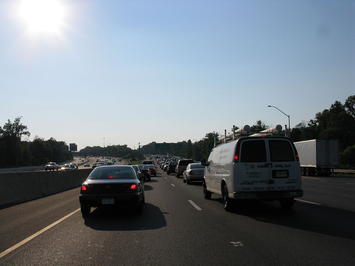
Late last month, the Federal Highway Administration reported that Americans drove a record number of miles in 2018: 3.225 trillion miles in all. While the Department of Transportation heralded this as a sign of a “robust economy,” detailed data show that driving grew by only 0.38 percent over 2017. This is slower than the previous year’s growth of 1.21 percent, and slower than the nation’s population growth of 0.62 percent, which means per capita driving declined by 0.24 percent.
While any growth at all is better than the transit industry is doing, this slow growth may be more of a sign of an on-coming recession than a robust economy. According to the Bureau of Economic Analysis, personal incomes declined by 0.1 percent in January, 2019, though they grew by 0.2 percent in February. Bloomberg says that some indicators suggest that we are facing the highest chance of a recession since 2008.
Of course, some people are using the growth in driving as one more argument for a big infrastructure spending bill. In fact, the need for a new federal spending program is becoming more questionable every day.
Both the Minnesota and Illinois state legislatures are considering hikes in state gas taxes to pay for infrastructure. On one hand, this suggests states can handle infrastructure needs without more federal spending. On the other hand, Minnesota and Illinois roads don’t really need a lot more spending.
Spending advocates are running an advertising campaign in Illinois implying that structurally deficient bridges are killing people. In fact, the number of structurally deficient bridges in Illinois has declined by more than 50 percent since 1992. Moreover, in the past 30 years, not a single bridge has collapsed in Illinois, or anywhere else, because it was structurally deficient.
A part of a bridge that recently fell in Tennessee failed due an oversized load; the bridge was not considered structurally deficient. The last bridge that did collapse due to lack of maintenance was also in Tennessee, and that was 30 years and four days ago.
The number of structurally deficient bridges in Minnesota has declined by 75 percent in the same time period. In both states, records indicate that the average roughness index of all types of roads has significantly declined — meaning the roads are getting smoother. So there seems to be no pressing need for gas tax increases to pay for roads.
What is collapsing is transit ridership and transit infrastructure. According to the Illinois Economic Policy Institute (which supports a gas tax increase), more than 80 percent of Illinois’ transportation infrastructure needs are transit, while less than 20 percent are roads ($41 billion vs. $10 billion). In advocating for a gas tax increase, the group is supporting wealth transfers from downstate Illinois to Chicago (which has most of the state’s transit infrastructure) and from low-income people (who are more likely to drive than take transit) to high-income people (who now make up the bulk of Chicago transit riders).
Of course, advocates of the tax increases don’t admit this in public, instead playing on public fears of bridge collapses and similar problems. Yet to the extent that any funding for roads is really need, it can be achieved by ending diversions of gas taxes to transit. According the Federal Highway Administration, in 2016 more than half of Minnesota gas taxes and a third of Illinois gas taxes were diverted to transit (and diversions of vehicle registration fees were similar). Ending such diversions would double Minnesota road funds and increase Illinois funds by 50 percent.
Such diversions should not be necessary. In the long run, spending on transit infrastructure is a waste because ridership is declining. In the short run, instead of repairing worn-out transit infrastructure, both Chicago and the Twin Cities should replace the trains that use such infrastructure with buses. That would eliminate the need for huge infrastructure spending on transit and could actually lead to improved transit service because buses are so much more flexible than trains.
This piece originally appeared on The Antiplanner.
Randal O’Toole is the director of the Independence Institute’s Transportation Policy Center and author of the recent book, Romance of the Rails: Why the Passenger Trains We Love Are Not the Transportation We Need.
Photo Credit: thisisbossi from Washington, DC, USA [CC BY-SA 2.0], via Wikimedia Commons












